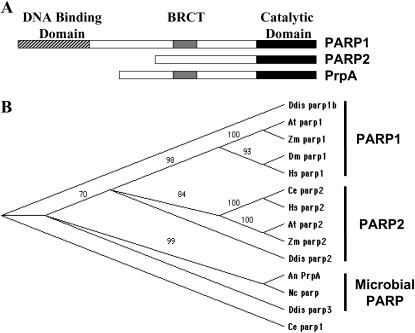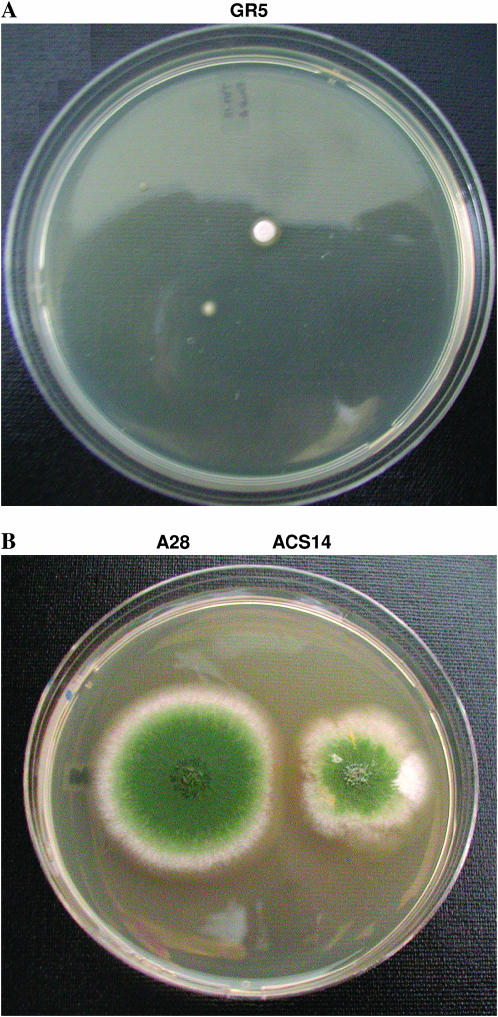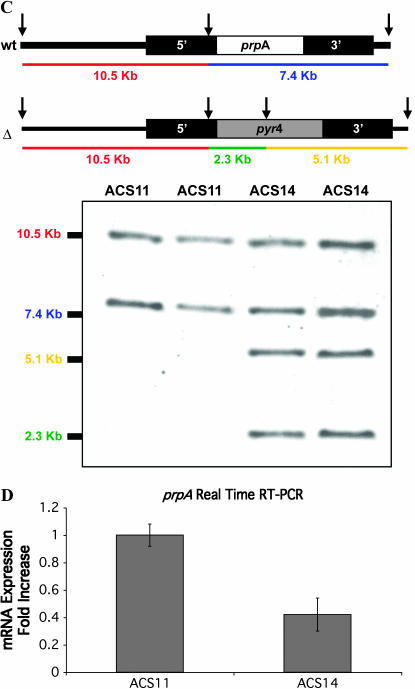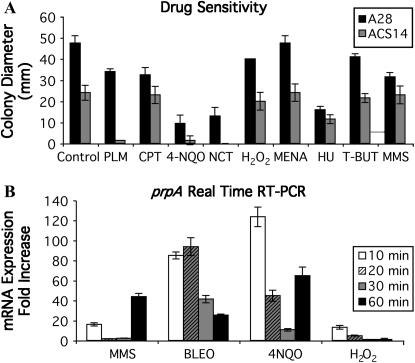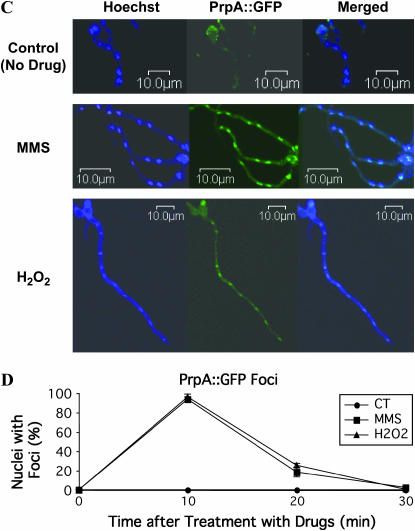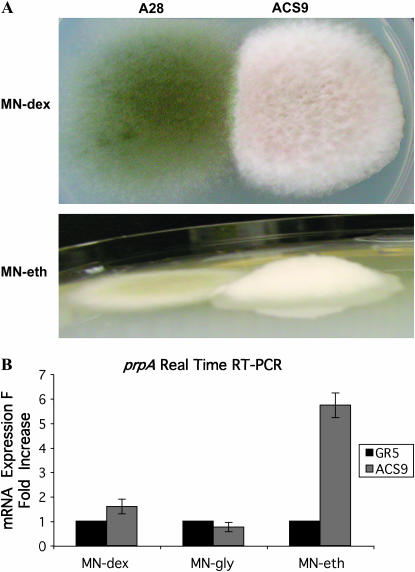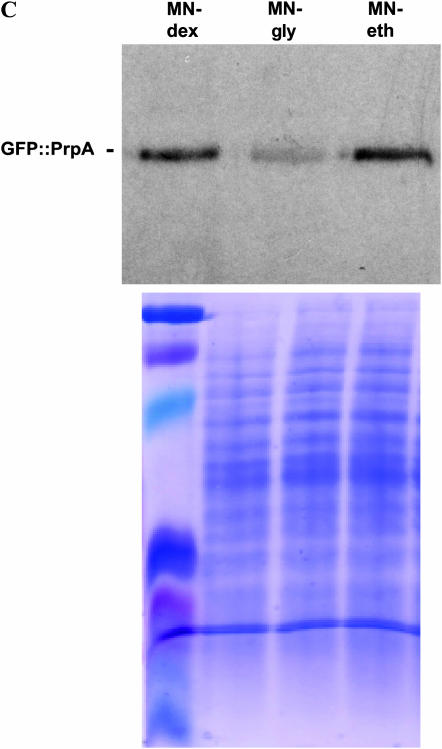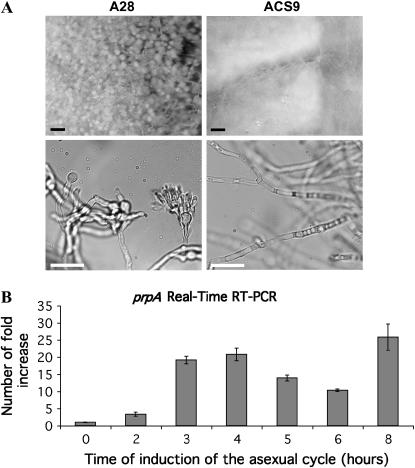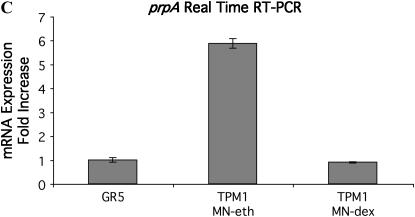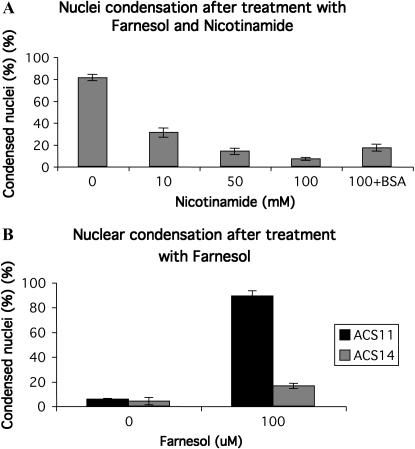Abstract
POLY(ADP-RIBOSE) polymerase (PARP) is a highly conserved enzyme involved in multiple aspects of animal and plant cell physiology. For example, PARP is thought to be intimately involved in the early signaling events that trigger the DNA damage response. However, the genetic dissection of PARP function has been hindered by the presence of multiple homologs in most animal and plant species. Here, we present the first functional characterization of a putative PARP homolog (PrpA) in a microbial system (Aspergillus nidulans). PrpA belongs to a group of PARP homologs that includes representatives from filamentous fungi and protists. The genetic analysis of prpA demonstrates that it is an essential gene whose role in the DNA damage response is sensitive to gene dosage. Notably, temporal patterns of prpA expression and PrpA–GFP nuclear localization suggest that PrpA acts early in the A. nidulans DNA damage response. Additional studies implicate PrpA in farnesol-induced cell death and in the initiation of asexual development. Collectively, our results provide a gateway for probing the diverse functions of PARP in a sophisticated microbial genetic system.
POLY(ADP-RIBOSE) polymerase (PARP) consumes NAD+ to catalyze the formation of ADP-ribosyl groups on target proteins. Modification of a target by PARP is a rapid response capable of altering protein activity and/or stability (reviewed by Jagtap and Szabo 2005 and Kim et al. 2005). Accordingly, PARP plays an integral role in the cellular response to a variety of stresses, most notably DNA damage (reviewed by Ame et al. 2004). In animal cells, the presence of a DNA strand break triggers localized PARP activation at the damage site, which in turn leads to auto-modification of PARP and the ADP ribosylation of histone H1 (D'Amours et al. 1999). These effects facilitate DNA repair by promoting localized relaxation of chromatin (Poirier et al. 1982; de Murcia et al. 1988). In addition, PARP activity has also been implicated in the recruitment of the key DNA repair proteins such as XRCC1 and single-strand break proteins (Okano et al. 2003). As repair proceeds, ADP-ribosyl groups are degraded by poly(ADP-ribose) glycohydrolase (PARG) (D'Amours et al. 1999; Davidovic et al. 2001), thereby permitting restoration of the native chromatin structure. Persistent PARP activation may signal the presence of irreparable DNA damage. In this case, PARP has been shown to promote caspase-independent cell death by inducing the release of the proapoptotic protein apoptosis-inducing factor (AIF) from mitochondria (Yu et al. 2002; Ame et al. 2004). Independent of its role in the DNA damage response, PARP is involved in several other cellular functions. For example, the level of PARP activity is thought to play a decisive role in the regulation of cell death. In particular, excessive activity appears to promote necrosis by depleting ATP pools that would otherwise be utilized for apoptosis (Decker and Muller 2002; Bouchard et al. 2003; Edinger and Thompson 2004). In addition, PARP is intimately involved in diverse processes such as the regulation of gene expression, organization of the mitotic spindle, and development (summarized in Kim et al. 2005).
The canonical PARP enzyme, human PARP1, is a 116-kDa protein that consists of three domains: an N-terminal DNA-binding domain containing two zinc fingers and a nuclear localization sequence, a central auto-modification domain that includes a BRCA1 C-terminus domain (BRCT) motif, and a C-terminal catalytic domain (summarized by Ame et al. 2004 and Kim et al. 2005). PARP enzymes have been identified throughout the animal and plant kingdoms, with the catalytic domain exhibiting the greatest degree of sequence similarity. Indeed, members of the PARP superfamily are defined by the presence of this domain. By contrast, the DNA-binding and auto-modification domains are not very well conserved and are usually replaced with alternative domains that reflect the function of a specific PARP isoform (Ame et al. 2004). The functional characterization of PARP isoforms has typically relied upon the construction of knockout mutants or the alteration of PARP expression (Kim et al. 2005). However, this type of approach has been limited by functional redundancy among PARP isoforms. For example, the functions of PARP1 and PARP2 may overlap during the DNA damage response, but the embryonic lethality of parp1−/− parp2−/− double mutants has precluded systematic attempts to determine the consequences of complete PARP inactivation (Menissier de Murcia et al. 2003). The existence of several small molecule inhibitors that target the PARP catalytic domain has also permitted the use of chemical genetics, but these studies are potentially compromised by the likelihood that PARP has additional “scaffolding” functions that are not affected by the inhibitors (Jagtap and Szabo 2005). Although these problems could conceivably be circumvented by the use of microbial genetics, PARP function has not yet been characterized in any microbial system. Notably, no recognizable homolog of PARP exists in the proteome of either Saccharomyces cerevisiae or Schizosaccharomyces pombe.
The filamentous fungus Aspergillus nidulans possesses a sophisticated DNA damage response that ensures the maintenance of genome integrity (reviewed by Goldman et al. 2002). Characterization of this response has revealed that key regulatory proteins such as UvsBATR, AtmAATM, components of the Mre11 complex (ScaANBS1, MreAMRE11, and SldIRAD50), the cdc2-related kinase NpkA, the signalosome, and SepBCTF4 promote DNA repair and cell cycle arrest (Hofmann and Harris 2000; Bruschi et al. 2001; Semighini et al. 2003; Fagundes et al. 2004, 2005; Lima et al. 2005; Gygax et al. 2005; Malavazi et al. 2005, 2006). However, it remains unclear how hyphal cells initially sense the presence of DNA damage and trigger the appropriate repair and checkpoint pathways. Moreover, because A. nidulans hyphae are multicellular (Harris 1997), their response to DNA damage is likely to be more complex than the well-characterized response of yeast cells. To determine if A. nidulans possesses DNA damage response functions that are uniquely conserved with multicellular eukaryotes, the recently completed and annotated A. nidulans genome sequence was screened for homologs of repair and DNA damage signaling proteins that are not conserved in S. cerevisiae or S. pombe. This screen uncovered a single PARP homolog that is conserved in all filamentous fungi and is closely related to animal and plant PARP1. Thrane et al. (2004) also noted the existence of this homolog and provided evidence that it is subjected to caspase-mediated cleavage. In this study, we show that the putative A. nidulans PARP homolog, PrpA, is an essential protein that functions early in the DNA damage response. We also demonstrate that PrpA is required for programmed cell death and for asexual development. Our results suggest that PARP-mediated ADP ribosylation may be a broadly important feature of fungal physiology.
MATERIALS AND METHODS
Strains and growth conditions:
All strains used are described in Table 1. Media used include MAG (2% dextrose, 2% malt extract, 0.2% peptone, trace elements, vitamins, pH 6.5), CM (1% dextrose, 0.2% peptone, 0.1% yeast extract, 0.1% casamino acids, nitrate salts, trace elements, and vitamins, pH 6.5), minimal (MN)–dextrose (1% dextrose, nitrate salts, trace elements, vitamins, pH 6.5), MN–glycerol (MN with dextrose replaced by 1.2% glycerol), MN–ethanol (MN with dextrose replaced by 1.2% ethanol), and YGV (2% dextrose, 0.5% yeast extract, vitamins). Nitrate salts, trace elements, and vitamins were as described previously (Kafer 1977). Uridine and uracil were added to a final concentration of 5 and 10 mm, respectively, as necessary to complement the pyrimidine auxotrophy caused by the pyrG89 marker. Bleomycin (BLEO), camptothecin (CPT), hydrogen peroxide (H2O2), hydroxyurea (HU), menadione (MENA), methyl methanesulfonate (MMS), nicotinamide (NCT), 4-nitroquinoline oxide (4-NQO), phleomycin (PLM), trans-trans farnesol, and t-butyl hydroxyl peroxide (T-BUT) were added to the media at the indicated concentration. Most chemicals were purchased from Sigma Chemical, with the exception of PLM, which was purchased from InvivoGen. Stock solutions of CPT, HU, 4-NQO, and MENA were prepared in dimethyl sulfoxide, at concentrations of 100 mm, 5 m, 1 mg/ml, and 10 mm, respectively. A 0.5-m stock solution of NCT was prepared in water.
TABLE 1.
A. nidulans strains
| Strain | Genotype | Source |
|---|---|---|
| A28 | pabaA6; biA1 | FGSCa |
| ACS6 | pyrG89; wA3; pyroA4; prpA∷GFP∷pyr4 | This work |
| ACS9 | pyrG89; wA3; pyroA4; alcA∷GFP∷prpA∷ pyr4 | This work |
| ACS11 | pyrG89/pyrG89 | This work |
| ACS14 | pyrG89/pyrG89; ΔprpA∷pyr4/+ | This work |
| GR5 | pyrG89; wA3; pyroA4 | FGSCa |
| TPM1 | brA1; alcA∷abaA∷argB; metG | B. Millerb |
FGSC, Fungal Genetics Stock Center, Department of Microbiology, University of Kansas Medical Center, Lawrence, Kansas.
Bruce Miller, Department of Molecular Biology and Biochemistry, University of Idaho, Moscow, Idaho.
To count conidiospores, the back of a Pasteur pipette was used to excise a column of agar from the center of sporulating colonies. The agar blocks were transferred to a 15-ml Falcon tube containing 1 ml of water, the tube was vortexed for 1 min, and the resulting spore suspension was counted using a hematocytometer.
Cloning the prpA gene:
Standard methods were used to prepare genomic DNA and total RNA from lyophilized mycelia obtained from the strain A28. Both genomic and cDNA fragments were fully sequenced using gene-specific oligonucleotide primers (sequence available from authors upon request). The resulting prpA sequences were deposited at GenBank (accession nos. AY349148 and AY347573, respectively). A Northern blot was performed to verify the expression of prpA. Total RNA was extracted from strain A28 and 20 μg was fractionated in a 1.2% agarose formaldehyde gel. After transfer to Hybond N+ membrane (Amersham, Buckinghamshire, UK), hybridization was performed using [α-32P]dCTP primer-labeled cDNA probes spanning the conserved prpA catalytic and regulatory domains at its C terminus.
Real-time RT–PCR reactions:
Conidia of the indicated strains were inoculated into growth media and treated as described in the legends for Figures 4 and 5. Mycelia were harvested by filtration through a Whatman filter no. 1 (Nalgene) and total RNA was extracted and treated with RNAse-free DNAse (Promega, Madison, WI) as described previously (Semighini et al. 2002). Real-time RT–PCR reactions were performed using an ABI Prism 7700 sequence detection system (Perkin-Elmer Applied Biosystem) and the Taq-ManR EZ RT–PCR kit (Applied Biosystems, Foster City, CA) as described previously (Semighini et al. 2002). The measured quantities of each sample were normalized using tubC mRNA amplifications run in the same plate. Sequences of all primers and probes used are available from the authors upon request.
Construction of the ΔprpA strain:
A fusion PCR-mediated approach was used to construct the prpA gene replacement strain as previously described (Yang et al. 2004). Three initial amplifications generated 5′- and 3′-flanking regions of the prpA gene (using primers GSP1 and GSP2 and GSP3 and GSP4, respectively) and the pyr4 gene (using primers PYR1 and PYR2), which was employed as a selectable nutritional marker. A final fusion PCR using primers GSP1 and GSP4 amplified a full-length deletion cassette containing the three previous fragments. All PCR amplifications were performed using the Expand Long Template PCR kit (Boehringer Mannheim, Indianapolis) and the amplification conditions specified by Yang et al. (2004). The sequences of oligonucleotide primers were as follows: GSP1, 5′-GGTGCTTATGTTTACAACCGTCGC-3′; GSP2, 5′-TATACAGTAGGTCGCTTCGAATGGTTGCCG-3′; GSP3, 5′-ATCAAATCAACACCCGCCCTCGTATGA-3′; GSP4, 5′-TCACAGCACATCATCACCTTGGCTA-3′; PYR1, 5′-CGGCAACCATTCGAAGCGACCTACTGTATAATCTCCTTACGCATCTGTGCG-3′ (underlined bases indicate the region of homology to GSP2); PYR2, 5′-TCATACGAGGGCGGGTGTTGATTTGATATGCATCAGAGCAGATTGTACTG-3′ (underlined bases indicate the region of homology to GSP3).
Transformation of the pyrG89 strains GR5 and ACS11 was performed using a previously described protocol (Osmani et al. 1987) and 5 μg of the deletion cassette. Positive transformants were identified on the basis of their ability to grow on selective media. Southern blot analysis demonstrated that one full-length endogenous wild-type copy of prpA was lacking from the genome of one transformant (ACS14 strain).
Construction of the prpA∷GFP strain:
The C-terminal 1175 bp of the prpA coding region minus the stop codon was amplified from genomic DNA and cloned into pCR2.1-TOPO (Invitrogen, San Diego). Following digestion with KpnI and BamHI, the resulting fragment was cloned into KpnI/BamHI-digested pCP19 (Pearson et al. 2004). This generated a C-terminal prpA∷GFP fusion fragment that was transformed into strain GR5. Analysis of Southern blots identified transformants that had undergone homologous integration of the construct at the prpA locus. The desired transformants (i.e., strain ACS6) possess a full-length copy of prpA∷GFP expressed under the control of endogenous promoter sequences, plus an N-terminal fragment of prpA that is not fused to GFP and possesses no obvious promoter sequences. Expression of the recombinant PrpA∷GFP was confirmed by analysis of Western blots using both anti-GFP (Molecular Probes, Eugene, OR) and a commercial PARP antibody (Cell Signaling). Each antibody was used at a concentration of 1 μg/ml, and peroxidase-conjugated goat anti-rabbit (Sigma, St. Louis) was diluted to 1:10,000 was used as the secondary antibody. Because strain ACS6 is indistinguishable from wild-type controls strains in terms of radial growth rates, levels of conidiation, and resistance to DNA-damaging agents, we conclude that the PrpA∷GFP fusion is most likely a functional protein.
Construction of alcA∷GFP∷prpA strain:
An 852-bp fragment from the 5′-end of the prpA coding region was amplified from genomic DNA. After digestion with AcsI and PacI, the resulting fragment was cloned into AcsI/PacI-digested pMBC17ap (Efimov 2003), thereby producing a fusion of alcA(p)∷GFP to the 5′ half of prpA. Upon transformation into strain GR5, homologous integration at the prpA locus should generate a full-length alcA(p)∷GFP∷prpA fusion flanked by a truncated version of prpA regulated by native promoter sequences. Transformants were screened by PCR using a forward primer designed to recognize the alcA promoter sequence and a reverse primer designed to recognize the prpA sequence (starting at 1063 bp). Multiple transformants with the desired integration event were recovered, one of which (i.e., strain ACS9) was sequenced to verify homologous integration of the alcA(p)∷GFP∷prpA fusion. Expression of the fusion under control of the alcA promoter was confirmed by both real-time RT–PCR and the analysis of Western blots. For the real-time RT–PCR analysis, oligonucleotide primers that are capable of binding full-length prpA were used. For the Western analysis, blots of total protein extracts were probed with a 1:1000 dilution of a rabbit polyclonal anti-PARP antibody (Cell Signaling Technologies, no. 9542), followed by a 1:10,000 dilution of an alkaline phosphatase-conjugated anti-rabbit immunoglobulin G antibody (Sigma A3687). Bands were detected using enhanced chemiluminescence (Roche, Indianapolis).
Microscopy:
After 12 hr of germination on coverslips in YGV medium at 30°, strains were treated with DNA-damaging agents, oxidizing agents, or chemical inhibitors as indicated for each experiment. Coverslips were fixed and stained with Hoechst 33258 (Molecular Probes) as described by Harris et al. (1994). Slides were viewed using an Olympus BX51 fluorescent microscope and individual images were captured with a Photometrics CoolSnap HQ CCD camera. Confocal images were obtained with an Olympus FW500/BX61 confocal laser-scanning microscope using the following laser lines: 405 nm for Hoechst 33258 and 488 nm for GFP. Images were captured by direct acquisition with a Z step of 1 μm and were subsequently processed using Adobe PhotoShop 6.0.
RESULTS
PrpA is a putative PARP homolog:
A BLASTp search of the A. nidulans genome database (http://www.broad.mit.edu/annotation/fungi/aspergillus/) using human PARP1 as the query revealed a single open reading frame with significant homology. The potential homolog, AN3129.2, is a predicted 675-amino-acid protein that possesses homology to the C-terminal half of PARP1 (e-value 2e−82; 38% similarity and 55% identity). The homology is highest (48% identity and 62% similarity) in the predicted PARP catalytic domain that spans amino acids 306–673. In addition, like PARP1, AN3129.2 possesses a WGR domain (pfam 05406) between amino acids 188 and 270, and a BRCT motif (pfam 00533) extending from amino acids 26 to 84 (Figure 1A). The function of the WGR domain remains uncertain, although it has been annotated as a possible nucleic acid binding region, whereas the BRCT motif is known to mediate interactions between proteins involved in the DNA damage response (Glover et al. 2004). Notably, unlike PARP1, AN3129.2 does not possess an N-terminal zinc-finger DNA-binding motif (Figure 1A). The absence of this motif presumably accounts for the reduced length of AN3129.2 compared to PARP1. By the analysis of Northern blots and the sequencing of cDNA clones obtained through the use of RT–PCR, we verified that the AN3129.2 coding region harbors four introns and produces an ∼2.0-kb transcript. Hereafter, we refer to the predicted AN3129.2 protein as PrpA.
Figure 1.
PrpA is an ancestral PARP homolog. (A) Schematic of PARP1, PARP2, and PrpA proteins. PARP homologs possess three distinct domains: a zinc-finger DNA-binding domain (diagonal stripes), the BRCT-motif-containing auto-modification domain (shaded), and the PARP catalytic domain (solid). Amino acid sequences obtained from NCBI were submitted to a NCBI Conserved Domain Search. PARP1: Homo sapiens, P09874; PARP2: H. sapiens, Q9UGN5; and PrpA: A. nidulans, AY347573. (B) Phylogenetic tree representing the evolutionary relationship between PARP homologs. The tree was constructed from the amino acid sequences of the following PARP homologs: H. sapiens, Hs; Drosophila melanogaster, Dm; Caenorhabditis elegans, Ce; Arabidopsis thaliana, At; Zea mays, Zm; Dictyostelium discoideum, Dd; N. crassa, Nc; and A. nidulans, An. Sequences were obtained from NCBI (http://www.ncbi.nlm.hih.gov) or the Fungal Genome Initiative (http://www.broad.mit.edu/annotation/fungi/fgi/). The evolutionary relationship between PARP homologs was analyzed using ClustalW (MacVector, version 7.0, Oxford Molecular, Palo Alto, CA) to generate a multiple alignment of the sequences. The sequences were then displayed as a cladogram using the neighbor-joining method with bootstrap support (1000 repetitions). Clusters are grouped as PARP1, PARP2, and ancestral PARP subfamilies.
We sought to determine the extent to which PrpA is conserved throughout the fungal kingdom by performing BLAST searches of completed fungal genome sequences at the NCBI (http://www.ncbi.nih.gov/) and the Fungal Genome Initiative (http://www.broad.mit.edu/annotation/fungi/fgi/). This analysis revealed the existence of PARP homologs within the ascomycetes, basiodiomycetes, and zygomycetes. Notably, within the ascomycetes, annotated PrpA homologs were found in euascomycetes such as Neurospora crassa (NCU08852.1), Magnaporthe grisea (MG08613.4), and Fusarium graminearum (FG05924.1), but not in the hemiascomycetes (i.e., S. cerevisiae and close relatives Candida albicans and Yarrowia lipolytica) or the archiascomycetes (i.e., S. pombe). Within the basidiomycetes, a homolog was found in Coprinus cinereus, but not in the dimorphic species Crypotcoccus neoformans or Ustilago maydis. Finally, an apparent homolog was also identified in the zygomycete Rhizpus oryzae. The observed pattern of PrpA conservation shows that it is present in those filamentous fungi that form multicellular hyphae and/or sophisticated developmental structures, whereas it generally appears to have been lost in yeasts or dimorphic fungi that have prominent yeast growth phases. A phylogenetic analysis was performed to determine the relationship of PrpA to PARP1 and PARP2 homologs in both animals and plants (Figure 1B). Along with homologs found in Dictyostelium discoideum, the fungal PARPs form a distinct clade that appears more closely related to PARP2, which also does not possess zinc-finger DNA-binding motifs.
prpA is an essential gene and displays dose-dependent effects:
To determine the function of PrpA, we constructed a complete gene replacement using the fusion PCR-mediated approach described by Yang et al. (2004). Multiple attempts to transform this construct into the haploid strain GR5 yielded no viable transformants that could be subcultured under selective conditions (Figure 2A). Because this observation suggested that a prpA deletion might be lethal, we repeated the transformation using a diploid recipient strain (ACS11). This led to the recovery of a single diploid transformant (ACS14) in which one copy of prpA had been replaced with prpA∷pyrG, whereas the other copy remained intact (Figure 2B). Strain ACS14 was haploidized using standard approaches (Hastie 1970), but the only viable haploid segregants possessing the gene replacement also contained additional copies of prpA as determined by PCR and the analysis of Southern blots (data not shown). Taken together, these observations strongly suggest that prpA is an essential gene in A. nidulans. Although strain ACS14 is heterozygous for the prpA gene replacement (Figure 2C), it displayed a series of phenotypic defects when compared to a wild-type diploid strain (ACS11). First, ΔprpA/+ colonies are approximately one-half the diameter of wild-type controls (Figure 2B; also see Figure 5A). Second, ΔprpA/+ colonies frequently possess sectors (Figure 2B; 61.5%, n = 300) that presumably reflect genome instability (Kafer and Upshall 1973). Analysis of these sectors showed that they consist of diploid clones that had presumably undergone homologous recombination leading to loss of heterozygosity for either the wA or the yA spore color markers. Third, the ΔprpA/+ strain displayed sensitivity to numerous chemical compounds that cause DNA or oxidative damage (see Figure 5A). Notably, growing ΔprpA/+ hyphae were extremely sensitive to NCT, which is a known feedback inhibitor of PARP catalytic activity (Hageman and Stierum 2001). This result suggests that an ∼50% reduction of PARP activity in the ΔprpA/+ strain sensitized it to further inhibition of activity caused by NCT. Real-time RT–PCR was used to confirm that prpA transcript levels were reduced by ∼50% in the ΔprpA/+ strain relative to a wild-type diploid (Figure 2D). Collectively, the phenotypes displayed by strain ACS14 are consistent with the notion that prpA is a haplo-insufficient gene in A. nidulans, whereby a single functional copy of the gene cannot support the growth of a diploid strain or a heterokaryon.
Figure 2.
prpA is an essential gene that displays dose-dependent effects. (A) Colonies resulting from the transformation of the prpA deletion cassette construct into the haploid strain GR5. These small colonies appeared on selective media 4 days after transformation, but could not be subcultured into fresh selective media. Several attempts to transform this strain generated a similar phenotype. (B) Colonies of wild-type A28 (left) and ΔprpA/+ ACS14 (right) strains cultivated on selective medium. Note that the ACS14 colony is about one-half the diameter of the A28 colony and produces sectors that presumably reflect genome instability. (C) Southern analysis of the wild-type diploid ACS11 and ΔprpA/+ ACS14 strains. Genomic DNA from strains ACS11 and ACS14 was isolated and cleaved with the enzyme BamHI (restriction sites represented by an arrow). Note that in the deleted allele an extra BamHI site is created. The noncoding 5′ and 3′ regions of the prpA gene (black boxes) were used as a probe. In the wild-type diploid ACS11 strain, the probe recognizes two fragments (in red and blue), whereas in the ΔprpA/+ ACS14 strain, four fragments are recognized (in red, blue, yellow, and green), indicating that this strain has one wild-type and one deleted prpA allele. (D) Relative quantification of prpA mRNA expression in wild-type diploid ACS11 and ΔprpA/+ ACS14 strains by real-time RT–PCR. Each strain was grown in YGV liquid medium (plus uridine and uracil for ACS11) for 16 hr. Values represent the fold change in prpA expression compared to ACS11 (set as 1.0).
Figure 5.
PrpA participates in the DNA damage response. (A) Sensitivity of the ΔprpA/+ mutants to agents that cause DNA damage and oxidative stress. Strains were point inoculated on CM plates containing the following drug concentrations: 20 μg/ml PLM, 50 μm CPT, 0.25 μg/ml 4-NQO, 100 mm NCT, 50 μm H2O2, 0.1 μm MENA, 10 mm HU, 5 μm T-BUT, and 0.008% MMS. Colony diameters were measured after incubation at 30° for 7 days. Results shown are the average of two independent experiments. (B) Relative quantification of prpA mRNA expression in response to DNA damage as determined by real-time RT–PCR. The wild-type GR5 strain was grown in YGV liquid medium (plus uridine and uracil) for 16 hr. Mycelia were subsequently treated with 0.025% MMS, 0.6 μg/ml BLEO, 0.25 μg/ml of 4-NQO, or 50 μm H2O2 and incubated for 10, 20, 30, and 60 min. Values represent the fold change in prpA expression compared to GR5 grown in the absence of drugs. (B and C) PrpA localizes to the nucleus after DNA damage. (C) Conidiospores of the prpA∷GFP ACS6 strain were germinated on coverslips in YGV medium for 12 hr at 30°. The resulting hyphae were transferred to YGV containing no drug (control, top), 0.025% MMS (middle), or 50 μm H2O2 (bottom) and incubated at 30° for 10 min. Hyphae were fixed and stained with Hoechst 33258. Micrographs represent a z-series stack of 1-μm sections obtained by laser scanning confocal microscopy. Bars, 10 μm. (D) Percentage of nuclei that display PrpA∷GFP localization after 10, 20, and 30 min of the treatments described in B.
As an alternative approach to determining the effect of reduced PrpA function, we generated a promoter-dependent conditional allele, alcA(p)∷GFP∷prpA. When grown under alcA(p)-inducing conditions (i.e., MN–ethanol), multiple transformants possessing this allele grew normally, but possessed a pronounced fluffy phenotype caused by the inability to undergo asexual development (Figure 3A; see below). We verified that this phenotype cosegregated with the pyrG selectable marker (n = 100 segregants), thereby eliminating the possibility that it was caused by a spurious mutation. Surprisingly, when alcA(p) was repressed (i.e., MN–dextrose), growth remained normal and the fluffy phenotype persisted. It was only on nonrepressing, noninducing media (i.e., MN–glycerol) that the fluffy phenotype was not observed. To determine the basis for these observations, real-time RT–PCR was used to examine prpA expression levels under all three growth conditions. As expected, inducing conditions (i.e., MN–ethanol) led to a threefold induction of alcA(p)∷GFP∷prpA (Figure 3B). However, repressing conditions (i.e., MN–dextrose) also caused an unexpected minor induction of alcA(p)∷GFP∷prpA (Figure 3B). Similarly, Western analysis using a commercial anti-PARP antibody showed that GFP–PrpA levels were elevated on MN–ethanol and MN–dextrose (Figure 3C). Extensive analysis by PCR and DNA sequencing revealed that alcA(p)∷GFP∷prpA had integrated as expected at the prpA locus in strain ACS9 (data not shown). Furthermore, there were no associated rearrangements of the construct. Thus, at this time, it remains unclear why alcA(p)∷GFP∷prpA is expressed under supposed repressing conditions. Nevertheless, these results demonstrate that overexpression of PrpA causes dramatic developmental defects.
Figure 3.
Overexpression of PrpA results in asexual developmental defects. (A) Colonies of wild-type A28 (left) and alcA(p)∷GFP∷prpA ACS9 (right) strains grown in MN–dextrose (top) and MN–ethanol (bottom) media. Note that the ACS9 colony is fluffy in both media, thereby indicating a development defect. (B) Relative quantification of prpA mRNA expression by real-time RT–PCR in the wild-type GR5 and ACS9 strains. Each strain was grown in MN–dextrose liquid medium (plus uridine and uracil for GR5) for 12 hr. Mycelia were subsequently transferred to MN–dextrose, MN–glycerol, and MN–ethanol media and incubated an additional 6 hr. Values represent the fold change in prpA expression compared to GR5. (C) Western blot analysis of GFP∷PrpA levels in strain ACS9. Total protein was extracted from mycelia grown as described above. Blots were probed with a commercial anti-PARP antibody (Cell Signaling Technologies, no. 9542). An image of the Coomassie blue-stained gel is also shown to verify equal loading of each lane.
Regulated expression of prpA is required for asexual development:
In A. nidulans, the fluffy colony phenotype is usually diagnostic for defects in asexual development (reviewed by Adams et al. 1998). Accordingly, the fluffy phenotype observed when alcA(p)∷GFP∷prpA strains are grown on MN–ethanol (Figure 3A) suggests that proper regulation of PARP activity is required for conidiation. We confirmed that the fluffy phenotype was caused by a defect in conidiation by counting conidia produced by wild type and an alcA(p)∷GFP∷prpA strain after 7 days growth on MN–ethanol. This experiment revealed that overexpression of PrpA led to an ∼104-fold reduction in spore production (A28, 3.9 × 107 spores/ml; ACS9, <1 × 103 spores/ml; average of two independent experiments). Microscopic examination of the fluffy colonies showed that they largely consist of highly vacuolated aerial hyphae (Figure 4A).
Figure 4.
Regulated expression of prpA is required for asexual development. (A) Aconidial phenotype caused by increased expression of prpA. Conidiophores from wild-type (A28; left) and alcA(p)∷GFP∷prpA (ACS9; right) strains were examined under a dissecting scope (top: bars, 20 μm) and light microscopy (bottom: bars, 10 μm). Note that conidiophores of the wild-type strain develop specific asexual structures such as vesicles, metulae, phialides, and conidia, whereas the alcA(p)∷GFP∷prpA strain primarily forms vacuolated aerial hyphae. (B) Relative quantification of prpA mRNA expression during asexual development as determined by real-time RT–PCR. The wild-type GR5 strain was grown in YGV liquid medium (plus uridine and uracil) at 30° for 16 hr. The mycelial mass was then transferred to YGV plates and incubated at 30°. Exposure to an air interface stimulates conidiophore production. Accordingly, samples were collected at 0, 2, 3, 4, 5, 6, and 8 hr after transfer. (C) Relative quantification of prpA mRNA expression in an alcA(p)∷abaA strain using real-time RT–PCR. The wild-type GR5 and the alcA(p)∷abaA TPM1 strains were grown in MN liquid medium (plus uridine and uracil for GR5) for 12 hr. Mycelia were subsequently transferred to MN–dextrose or MN–ethanol media for an additional 6 hr. Values represent the fold change in prpA expression compared to GR5.
A synchronous development experiment was performed to address the possibility that PrpA expression is induced during conidiation in a wild-type strain. Using real-time RT–PCR, we found that prpA transcripts increase by 15- to 20-fold relative to controls after 3 hr of induction (Figure 4B). On the basis of microscopic examination of the developing cultures, prpA transcript accumulation initially coincided with the formation of vesicles on aerial stalks. Transcript levels then remained elevated (10- to 25-fold) throughout the 8-hr induction period (Figure 4B), which ended with the appearance of phialides-bearing spores. These observations confirm an earlier report that PARP protein levels are elevated during conidiation in A. nidulans (Thrane et al. 2004), but also demonstrate that induction does not coincide with the appearance of a specific cell type during asexual development.
A core transcriptional regulatory pathway controls developmental gene expression during conidiation in A. nidulans (reviewed by Adams et al. 1998). The two key transcriptional factors in this pathway are BrlA and AbaA, which bind to specific sequences in the promoters of developmentally regulated genes (Chang and Timberlake 1993; Andrianopoulos and Timberlake 1994). By scanning the 2000 bp located immediately upstream of the predicted prpA translational start site, we identified a single consensus BrlA-response element (−832CAAGGGG−826) and two consensus AbaA-binding sites (−1825CATTCT−1820; −1657CATTCC−1652). To determine if AbaA regulates the developmental induction of prpA, we employed a strain in which abaA expression is placed under control of the heterologous alcA promoter. When induced in submerged hyphal cultures that are normally not permissive for development, alcA∷abaA causes morphological changes that mimic conidiation (Mirabito et al. 1989). Using real-time RT–PCR, we found that induction of alcA∷abaA under these conditions (i.e., in MN–ethanol) triggered an approximately sixfold increase in prpA transcript levels (Figure 4C). These observations strongly suggest that prpA is a target of the core transcriptional pathway that regulates gene expression during conidiation.
Function of PrpA in the DNA damage response:
In animal cells, PARP is involved in signaling the presence of DNA damage and also regulates the recruitment of DNA repair enzymes to sites of damage (Ame et al. 2004). The presence of a single PARP homolog in A. nidulans provides a unique opportunity to determine the specific role(s) of PARP in the DNA damage response of a microbial system. We first confirmed that PrpA is involved in the A. nidulans DNA damage response by testing heterozygous ΔprpA/+ hyphae for sensitivity to a number of DNA-damaging agents. As shown in Figure 5A, the haplo-insufficient ΔprpA/+ mutant is particularly sensitive to PLM, which primarily causes double-strand breaks, and the UV mimetic agent 4-NQO. Although the mutant does not appear to be sensitive to other agents, such as CPT, HU, and MMS (Figure 5A), this may be because a single copy of prpA is sufficient for a normal response to these agents. At the very least, these observations implicate PrpA in the fungal DNA damage response.
To further assess the role of PrpA in the DNA damage response, we used real-time RT–PCR to examine transcript levels in hyphae exposed to DNA-damaging agents. Notably, expression of prpA was dramatically induced (i.e., 10- to 120-fold) in response to MMS, BLEO, or 4-NQO (Figure 5B). Moreover, this response was rapid, in that induction was evident within 10 min of treating hyphae with the DNA-damaging agent (Figure 5B). By contrast, other A. nidulans genes encoding proteins involved in DNA damage signaling and repair (i.e., scaANBS1, mreAMRE11, sldIRAD50) generally display peak transcript levels 1–2 hr after exposure (Semighini et al. 2003). This observation suggests that PrpA may function early in the fungal DNA damage response.
We have recently demonstrated that A. nidulans proteins involved in signaling the presence of DNA damage and in DNA repair (i.e., UvsCRAD51 and ScaANBS1) are recruited to nuclei following exposure to DNA-damaging agents (Fagundes et al. 2005; Gygax et al. 2005). To determine if PrpA displays a similar localization pattern, and to examine its kinetics, we constructed a functional PrpA∷GFP fusion that is expressed under control of native promoter sequences (see materials and methods). In the absence of DNA damage, PrpA∷GFP did not localize to any discrete structure in growing hyphae (Figure 5, C and D). However, upon exposure to a DNA-damaging agent (i.e., 0.025% MMS), PrpA∷GFP localized to nuclei (Figure 5, C and D). Most importantly, nuclear localization peaked at 10 min following exposure to DNA damage and had largely disappeared by 30 min (Figure 5D). By comparison, UvsCRAD51 typically cannot be detected in nuclei until at least 60 min after exposure (Gygax et al. 2005). These results provide additional support for the notion that PrpA acts early in the fungal DNA damage response. Moreover, they raise the possibility that PrpA may be recruited to sites of DNA damage.
Although the analysis of the ΔprpA/+ mutant did not reveal any sensitivity to oxidizing agents (i.e., H2O2, MENA, T-BUT; Figure 5A), we found that PrpA also localized to nuclei within 10 min of exposure to H2O2 (Figure 5, C and D). Furthermore, real-time RT–PCR analysis also revealed that prpA transcript levels increase ∼10-fold upon exposure to H2O2 (Figure 5B). These results may indicate that prpA is involved in the response to oxidative DNA damage.
PrpA is required for farnesol-induced cell death:
We have recently demonstrated that the small-molecule lipid farnesol causes apoptosis in A. nidulans in a manner that depends on functional mitochondria and the production of reactive oxygen species (Semighini et al. 2006). Because PARP activity has been implicated in an apoptosis pathway that requires mitochondria (Yu et al. 2002), we tested the role of PARP in farnesol-induced apoptosis. First, using nuclear condensation as a marker for cell death, we found that the PARP feedback inhibitor NCT suppressed the effects of farnesol (Figure 6A). Second, in a more specific test, we found that the ability of farnesol to trigger apoptosis was severely compromised in the ΔprpA/+ mutant (Figure 6B). In particular, a farnesol concentration (100 μm) that typically causes nuclear condensation in ∼90% of diploid wild-type hyphae caused a similar effect in <20% of ΔprpA/+ hyphae. This observation implicates PrpA in at least one fungal cell death pathway.
Figure 6.
PrpA is required for farnesol-induced programmed cell death. (A) Percentage of nuclei undergoing farnesol-induced DNA condensation in the presence of the PARP inhibitor NCT. Conidiospores of the A28 wild-type strain were germinated on coverslips in YGV medium for 12 hr at 30°. The resulting hyphae were transferred to YGV containing 100 μm farnesol and 0, 10, 50, or 100 mm of NCT. A control using 1% BSA and 100 μm of farnesol was also included. After 2 hr of incubation at 30°, germlings were fixed, stained with Hoechst 33258, and analyzed by fluorescence microscopy. (B) Percentage of nuclei undergoing farnesol-induced DNA condensation in the wild-type diploid ACS11 and ΔprpA/+ ACS14 strains. Conidiospores of both strains were germinated on coverslips in YGV medium (plus uridine and uracil for ACS11) for 12 hr at 30°. The resulting hyphae were transferred to YGV containing 100 μm farnesol and processed for microscopy as described in A.
DISCUSSION
PARP is a highly conserved enzyme that is intimately associated with multiple aspects of cellular physiology. Humans, and indeed most animals, possess multiple PARP-like proteins (reviewed by Ame et al. 2004). This has unfortunately confounded attempts to characterize the specific role of PARP in several cellular responses. For example, the essential function of PARP in the DNA damage response is not completely clear because PARP2 can apparently compensate for loss of PARP1 function in some cases (Ame et al. 2004; Kim et al. 2005). The identification of a single apparent PARP homolog in the model filamentous fungus A. nidulans provides an opportunity to unambiguously determine the conserved function of PARP. Here, we show that PrpA is an essential protein involved in the DNA damage response, mediates certain forms of cell death, and plays a role in asexual development. This is the first description of PARP function in a eukaryotic microorganism.
Genetics of PrpA:
A defining feature of the PARP superfamily of proteins is the presence of a highly conserved catalytic domain usually located at the C terminus (reviewed by Ame et al. 2004). Because the C-terminal half of PrpA possesses adjacent PARP catalytic (pfam00644) and PARP regulatory (pfam02877) domains, and because this is the region with the highest homology to other PARP homologs, we are extremely confident that PrpA is a bona fide PARP homolog. Furthermore, the presence of the BRCT motif and the WGR domain suggests that PrpA is more closely related to PARP1 and PARP2 than it is to other members of the PARP superfamily (Ame et al. 2004). However, several important questions remain unanswered. First, an N-terminal zinc-finger DNA-binding domain is conspicuously absent from PrpA. Accordingly, it is not clear how PrpA binds DNA. This function could be mediated by the WGR domain, which has been implicated in the binding of nucleic acids (i.e., see http://www.sanger.ac.uk/cgi-bin/Pfam/getacc?PF05406). Alternatively, PrpA may not bind DNA directly and may instead interact with a distinct zinc-finger DNA-binding protein. Second, PARP1 possesses a caspase cleavage site located in the DNA-binding domain (Kaufmann et al. 1993), and cleavage of PARP is recognized as an early marker for caspase-mediated apoptosis. However, no obvious caspase cleavage site is present in PrpA. Although it was previously reported that A. nidulans PARP could be cleaved by caspases in vitro (Thrane et al. 2004), we have not been able to confirm this observation using the same commercial antibody on in vivo extracts (C. Semighini and S. Harris, unpublished observations). Thus, if PrpA is cleaved at all, the relevant protease presumably acts at a novel site. Third, in animals and plants, PARP1 activity is countered by PARG (D'Amours et al. 1999; Davidovic et al. 2001), which cleaves ADP-ribose moieties from PARP substrates. Surprisingly, no obvious PARG homolog could be detected in the genome of A. nidulans or in any other sequenced filamentous fungal genome, despite exhaustive searches. Therefore, an alternative glucohydrolyase may be responsible for this function in filamentous fungi. Finally, it remains to be shown that PrpA does indeed possess PARP catalytic activity. If so, A. nidulans will provide a powerful system for the identification of relevant PARP substrates.
The functional characterization of PrpA is complicated by the observation that it appears to be an essential protein. Furthermore, attempts to generate a conditional allele were foiled by the failure of glucose to repress the expression of alcA(p)-regulated prpA. At this time, we have no explanation for the failed repression, but it has been observed in multiple transformants in different strain backgrounds (C. Semighini and S. Harris, unpublished observations). Therefore, the future functional characterization of PrpA will likely depend on the construction of specific mutations that affect its catalytic activity or possible scaffolding functions.
Haplo-insufficiency is a common genetic phenomenon that in most cases has been attributed to gene dosage effects (Seidman and Seidman 2002). Indeed, a recent comprehensive study in yeast found that 3% of ∼5900 tested genes were haplo-insufficient (Deutschbauer et al. 2005). Notably, most of the haplo-insufficient genes were implicated in basic cellular processes, thereby suggesting that insufficient protein production was the underlying cause. We suspect that this is also the basis for the haplo-insufficient phenotypes displayed by the ΔprpA/+ mutant. The alternative hypothesis that haplo-insufficiency is caused by the altered stoichiometry of components within a multi-protein complex predicts that overexpression and haplo-insufficient phenotypes would be the same (Papp et al. 2003), which was not observed in our case. Strikingly, PARP1 haplo-insufficient phenotypes have been observed in mammalian cells (Hande 2004) and other important DNA damage signaling proteins (i.e., ATM and BLM; Goss et al. 2002; Spring et al. 2002) also display gene dosage effects. These observations suggest that the levels of key regulatory proteins may be precisely calibrated during the DNA damage response.
Role of PrpA in the responses to DNA damage and cellular stress:
Three observations suggest that PrpA is involved in the fungal DNA damage response. First, the ΔprpA/+ mutant is sensitive to the DNA-damaging agents PLM and 4-NQO. Second, prpA transcript levels accumulate within 10 min of exposure to DNA-damaging agents. Third, PrpA transiently localizes to nuclei within a 10- to 20-min window after exposure to DNA damage. Because the increased expression and nuclear localization of other DNA damage signaling and repair proteins typically occurs within 1–2 hr after DNA damage (Semighini et al. 2003; Fagundes et al. 2005; Gygax et al. 2005), these observations imply that PrpA performs an early signaling function in the DNA damage response. By analogy to PARP1 (D'Amours et al. 1999), PrpA may be rapidly recruited to DNA damage sites, where it initiates signaling events that lead to the subsequent recruitment of DNA damage checkpoint and repair complexes. Given the known roles of PARP1 in the regulation of chromatin structure (Tulin and Spradling 2003; Kim et al. 2005), the key early function of PrpA may be chromatin remodeling at DNA damage sites. Although the relationship between PARP1 and other DNA damage signaling proteins appears complex (Watanabe et al. 2004), our preliminary observations show that the A. nidulans ATM homolog is required for PrpA nuclear localization (C. Semighini and S. Harris, unpublished observations). Additional dependency studies and double-mutant analyses will help to clarify the roles of PrpA in DNA damage signaling and repair.
A variety of cellular stresses are capable of causing apoptosis in the filamentous fungi (Cheng et al. 2003; Mousavi and Robson 2004; Chen and Dickman 2005; Leiter et al. 2005). We have recently shown that farnesol, a small 15-carbon lipid, triggers apoptosis in A. nidulans via a mechanism that depends on the accumulation of reactive oxygen species and requires functional mitochondria (Semighini et al. 2006). PARP1 mediates a caspase-independent form of cell death by promoting the transfer of AIF from mitochondria to nuclei, where it triggers the hydrolysis of chromatin (Yu et al. 2002). Accordingly, the role of PrpA in the farnesol-induced response suggests that a functionally analogous pathway involving an AIF homolog may control cell death in A. nidulans (see Cheng et al. 2003).
Role of PrpA in asexual development:
Our observations show that the core BrlA- and AbaA-dependent transcriptional regulatory circuit directs the induction of prpA expression during asexual development. When this regulatory circuit is broken by the fusion of prpA to the alcA promoter, conidiation does not proceed and instead fluffy aconidial colonies are formed. These results imply that the proper regulation of PrpA function is crucial for subsequent development. This may reflect a role for PARP modification in controlling the expression and/or activity of important development proteins. For example, PrpA-mediated chromatin modification may control the derepression of sporulation-specific gene clusters such as spoC1 (Miller et al. 1987). Alternatively, PrpA expression may affect the cytoskeleton or other cytoplasmic functions important for cellular morphogenesis during asexual development. Notably, in Drosophila, overexpression of PARP1 disrupts actin organization by suppressing Rho GTPase function (Uchida et al. 2002).
Finally, there is a striking correlation between the conservation of PARP and the ability of fungi to form multicellular hyphae and/or developmental structures. PARP homologs are not present in S. cerevisiae and S. pombe and also appear to be missing from the dimorphic basidiomycetes U. maydis and C. neoformans. This observation may be instructive in that it emphasizes the correlation between PARP function and a multicellular lifestyle. Another protein that displays a similar conservation pattern in fungi is NADPH oxidase (Lalucque and Silar 2003), which has been implicated in intercellular signaling during sexual development in A. nidulans (Lara-Ortiz et al. 2003). Thus, A. nidulans may provide an attractive model system for elucidating the ancestral function of proteins whose importance is linked with multicellularity.
Acknowledgments
We thank Everaldo dos Reis Marques for his assistance with Northern blot experiments and all members of the Microscopy Core (University of Nebraska Center for Biotechnology) for their invaluable help with confocal microscopy. We also thank Wilhelm Hansberg (Universidad Nacional Autonoma de Mexico) for valuable discussions. Support was provided by the Nebraska Research Foundation (S.H.), Fundação de Amparo a Pesquisa do Estado de São Paulo, and Conselho Nacional de Desenvolvimento Científico e Tecnológico (G.H.G.).
References
- Adams, T. H., J. K. Wieser and J. H. Yu, 1998. Asexual sporulation in Aspergillus nidulans. Microbiol. Mol. Biol. Rev. 62: 35–54. [DOI] [PMC free article] [PubMed] [Google Scholar]
- Ame, J. C., C. Spenlehauer and G. de Murcia, 2004. The PARP superfamily. BioEssays 26: 882–893. [DOI] [PubMed] [Google Scholar]
- Andrianopoulos, A., and W. E. Timberlake, 1994. The Aspergillus nidulans abaA gene encodes a transcriptional activator that acts as a genetic switch to control development. Mol. Cell. Biol. 14: 2503–2515. [DOI] [PMC free article] [PubMed] [Google Scholar]
- Bouchard, V. J., M. Rouleau and G. G. Poirier, 2003. PARP-1, a determinant of cell survival in response to DNA damage. Exp. Hematol. 31: 446–454. [DOI] [PubMed] [Google Scholar]
- Bruschi, G. C. M., C. C. de Souza, M. R. Z. K. Fagundes, M. A. C. Dani, M. H. S. Goldman et al., 2001. Sensitivity to camptothecin in Aspergillus nidulans identified a novel gene, scaA, related to the cellular DNA damage response. Mol. Genet. Genomics 265: 264–275. [DOI] [PubMed] [Google Scholar]
- Chang, Y. C., and W. E. Timberlake, 1993. Identification of Aspergillus brlA response elements (BREs) by genetic selection in yeast. Genetics 133: 29–38. [DOI] [PMC free article] [PubMed] [Google Scholar]
- Chen, C., and M. B. Dickman, 2005. Proline suppresses apoptosis in the fungal pathogen Colletotrichum trifolii. Proc. Natl. Acad. Sci. USA 102: 3459–3464. [DOI] [PMC free article] [PubMed] [Google Scholar]
- Cheng, J., T. S. Park, L. C. Chio, A. S. Fischl and X. S. Ye, 2003. Induction of apoptosis by sphingoid long-chain bases in Aspergillus nidulans. Mol. Cell. Biol. 23: 163–177. [DOI] [PMC free article] [PubMed] [Google Scholar]
- D'Amours, D., S. Desnoyers, L. D'Silva, and G. G. Poirier, 1999. Poly(ADP-ribosyl)ation reactions in the regulation of nuclear functions. Biochem. J. 342: 249–268. [PMC free article] [PubMed] [Google Scholar]
- Davidovic, L., M. Vodenicharov, E. B. Affar and G. G. Poirier, 2001. Importance of poly(ADP-ribose) glycohydrolase in the control of poly(ADP-ribose) metabolism. Exp. Cell Res. 268: 7–13. [DOI] [PubMed] [Google Scholar]
- Decker, P., and S. Muller, 2002. Modulating poly (ADP-ribose) polymerase activity: potential for the prevention and therapy of pathogenic situations involving DNA damage and oxidative stress. Curr. Pharm. Biotechnol. 3: 275–283. [DOI] [PubMed] [Google Scholar]
- de Murcia, G., A. Huletsky and G. G. Poirier, 1988. Modulation of chromatin structure by poly(ADP-ribosyl)ation. Biochem. Cell Biol. 66: 626–635. [DOI] [PubMed] [Google Scholar]
- Deutschbauer, A. M., D. F. Jaramillo, M. Proctor, J. Kumm, M. E. Hillenmeyer et al., 2005. Mechanisms of haploinsufficiency revealed by genome-wide profiling in yeast. Genetics 169: 1915–1925. [DOI] [PMC free article] [PubMed] [Google Scholar]
- Edinger, A. L., and C. B. Thompson, 2004. Death by design: apoptosis, necrosis and autophagy. Curr. Opin. Cell Biol. 16: 663–669. [DOI] [PubMed] [Google Scholar]
- Efimov, V. P., 2003. Roles of NUDE and NUDF proteins of Aspergillus nidulans: insights from intracellular localization and overexpression effects. Mol. Biol. Cell 14: 871–888. [DOI] [PMC free article] [PubMed] [Google Scholar]
- Fagundes, M. R. Z. K., J. F. Lima, M. Savoldi, I. Malavazi, R. E. Larson et al., 2004. The Aspergillus nidulans npkA gene encodes a Cdc2-related kinase that genetically interacts with the UvsBATR kinase. Genetics 167: 1629–1641. [DOI] [PMC free article] [PubMed] [Google Scholar]
- Fagundes, M. R. Z. K., C. P. Semighini, I. Malavazi, M. Savoldi, J. F. Lima et al., 2005. Aspergillus nidulans uvsBATR and scaANBS1 genes show genetic interactions during recovery from replication stress and DNA damage. Eukaryot. Cell 4: 1239–1252. [DOI] [PMC free article] [PubMed] [Google Scholar]
- Glover, J. N., R. S. Williams and M. S. Lee, 2004. Interactions between BRCT repeats and phosphoproteins: tangled up in two. Trends Biochem. Sci. 29: 579–585. [DOI] [PubMed] [Google Scholar]
- Goldman, G. H., S. L. McGuire and S. D. Harris, 2002. The DDR in filamentous fungi. Fungal Genet. Biol. 35: 183–195. [DOI] [PubMed] [Google Scholar]
- Goss, K. H., M. A. Risinger, J. J. Kordich, M. M. Sanz, J. E. Straughen et al., 2002. Enhanced tumor formation in mice heterozygous for Blm mutation. Science 297: 2051–2053. [DOI] [PubMed] [Google Scholar]
- Gygax, S. E., C. P. Semighini, G. H. Goldman and S. D. Harris, 2005. SepBCTF4 is required for the formation of DNA damage-induced UvsCRAD51 foci in Aspergillus nidulans. Genetics 169: 1391–1402. [DOI] [PMC free article] [PubMed] [Google Scholar]
- Hageman, G. J., and R. H. Stierum, 2001. Niacin, poly(ADP-ribose) polymerase-1 and genomic stability. Mutat. Res. 475: 45–56. [DOI] [PubMed] [Google Scholar]
- Hande, M. P., 2004. DNA repair factors and telomere-chromosome integrity in mammalian cells. Cytogenet. Genome Res. 104: 116–122. [DOI] [PubMed] [Google Scholar]
- Harris, S. D., 1997. The duplication cycle in Aspergillus nidulans. Fungal Genet. Biol. 22: 1–12. [DOI] [PubMed] [Google Scholar]
- Harris, S. D., J. L. Morrell and J. E. Hamer, 1994. Identification and characterization of Aspergillus nidulans mutants defective in cytokinesis. Genetics 136: 517–532. [DOI] [PMC free article] [PubMed] [Google Scholar]
- Hastie, A. C., 1970. Benlate induced instability of Aspergillus diploids. Nature 226: 771. [DOI] [PubMed] [Google Scholar]
- Hofmann, A. F., and S. D. Harris, 2000. The Aspergillus nidulans uvsB gene encodes an atm-related kinase required for multiple facets of the DNA damage response. Genetics 154: 1577–1586. [DOI] [PMC free article] [PubMed] [Google Scholar]
- Jagtap, P., and C. Szabo, 2005. Poly(ADP-ribose) polymerase and the therapeutic effects of its inhibitors. Nat. Rev. Drug Discov. 4: 421–440. [DOI] [PubMed] [Google Scholar]
- Kafer, E., 1977. Meiotic and mitotic recombination in Aspergillus and its chromosomal aberrations. Adv. Genet. 19: 33–131. [DOI] [PubMed] [Google Scholar]
- Kafer, E., and A. Upshall, 1973. The phenotypes of the eight disomics and trisomics of Aspergillus nidulans. J. Hered. 64: 35–38. [DOI] [PubMed] [Google Scholar]
- Kaufmann, S. H., S. Desnoyers, Y. Ottaviano, N. E. Davidson and G. G. Poirier, 1993. Specific proteolytic cleavage of poly (ADP-ribose) polymerase: an early marker of chemotherapy-induced apoptosis. Cancer Res. 53: 3976–3985. [PubMed] [Google Scholar]
- Kim, M. Y., T. Zhang and W. L. Kraus, 2005. Poly(ADP-ribosyl)ation by PARP-1: ‘PAR-laying’ NAD+ into a nuclear signal. Genes Dev. 19: 1951–1967. [DOI] [PubMed] [Google Scholar]
- Lalucque, H., and P. Silar, 2003. NADPH oxidase: An enzyme for multicellularity? Trends Microbiol. 11: 9–12. [DOI] [PubMed] [Google Scholar]
- Lara-Ortiz, T., H. Riveros-Rosas and J. Aguirre, 2003. Reactive oxygen species generated by microbial NADPH oxidase NoxA regulate sexual development in Aspergillus nidulans. Mol. Microbiol. 50: 1241–1255. [DOI] [PubMed] [Google Scholar]
- Leiter, E., H. Szappanos, C. Oberparleiter, L. Kaiserer, L. Csernoch et al., 2005. Antifungal protein PAF severely affects the integrity of the plasma membrane of Aspergillus nidulans and induces an apoptosis-like phenotype. Antimicrob. Agents Chemother. 49: 2445–2453. [DOI] [PMC free article] [PubMed] [Google Scholar]
- Lima, J. F., I. Malavazi, M. R. Fagundes, M. Savoldi, M. H. Goldman et al., 2005. The csnD/csnE signalosome genes are involved in the Aspergillus nidulans DNA damage response. Genetics 171: 1003–1015. [DOI] [PMC free article] [PubMed] [Google Scholar]
- Malavazi, I., J. F. Lima, M. R. von Zeska Kress Fagundes, V. P. Efimov, M. H. de Souza Goldman et al., 2005. The Aspergillus nidulans sldI(RAD50) gene interacts with bimE(APC1), a homologue of an anaphase-promoting complex subunit. Mol. Microbiol. 57: 222–237. [DOI] [PubMed] [Google Scholar]
- Malavazi, I., C. P. Semighini, M. R. von Zeska Kress, S. D. Harris and G. H. Goldman, 2006. Regulation of hyphal morphogenesis and the DNA damage response by the Aspergillus nidulans ATM homolog AtmA. Genetics 173: 99–109. [DOI] [PMC free article] [PubMed] [Google Scholar]
- Menissier de Murcia, J., M. Ricoul, L. Tartier, C. Niedergang, A. Huber et al., 2003. Functional interaction between PARP-1 and PARP-2 in chromosome stability and embryonic development in mouse. EMBO J. 22: 2255–2263. [DOI] [PMC free article] [PubMed] [Google Scholar]
- Miller, B. L., K. Y. Miller, K. A. Roberti and W. E. Timberlake, 1987. Position-dependent and -independent mechanisms regulate cell-specific expression of the SpoC1 gene cluster of Aspergillus nidulans. Mol. Cell. Biol. 7: 427–434. [DOI] [PMC free article] [PubMed] [Google Scholar]
- Mirabito, P. M., T. H. Adams and W. E. Timberlake, 1989. Interactions of three sequentially expressed genes control temporal and spatial specificity in Aspergillus development. Cell 57: 859–868. [DOI] [PubMed] [Google Scholar]
- Mousavi, S. A., and G. D. Robson, 2004. Oxidative and amphotericin B-mediated cell death in the opportunistic pathogen Aspergillus fumigatus is associated with an apoptotic-like phenotype. Microbiology 150: 1937–1945. [DOI] [PubMed] [Google Scholar]
- Okano, S., L. Lan, K. W. Caldecott, T. Mori and A. Yasui, 2003. Spatial and temporal cellular responses to single-strand breaks in human cells. Mol. Cell. Biol. 23: 3974–3981. [DOI] [PMC free article] [PubMed] [Google Scholar]
- Osmani, S. A., G. S. May and N. R. Morris, 1987. Regulation of the mRNA levels of nimA, a gene required for the G2-M transition in Aspergillus nidulans. J. Cell Biol. 104: 1495–1504. [DOI] [PMC free article] [PubMed] [Google Scholar]
- Papp, B., C. Pal and L. D. Hurst, 2003. Dosage sensitivity and the evolution of gene families in yeast. Nature 424: 194–197. [DOI] [PubMed] [Google Scholar]
- Pearson, C. L., K. Xu, K. E. Sharpless and S. D. Harris, 2004. MesA, a novel fungal protein required for the stabilization of polarity axes in Aspergillus nidulans. Mol. Biol. Cell 15: 3658–3672. [DOI] [PMC free article] [PubMed] [Google Scholar]
- Poirier, G. G., G. de Murcia, J. Jongstra-Bilen, C. Niedergang and P. Mandel, 1982. Poly(ADP-ribosyl)ation of polynucleosomes causes relaxation of chromatin structure. Proc. Natl. Acad. Sci. USA 79: 3423–3427. [DOI] [PMC free article] [PubMed] [Google Scholar]
- Seidman, J. G., and C. Seidman, 2002. Transcription factor haploinsufficiency: when half a loaf is not enough. J. Clin. Invest. 109: 451–455. [DOI] [PMC free article] [PubMed] [Google Scholar]
- Semighini, C. P., M. Marins, M. H. S. Goldman and G. H. Goldman, 2002. Quantitative analysis of the relative transcript levels of ABC transporter Atr genes in Aspergillus nidulans by real-time reverse transcription-PCR assay. Appl. Environ. Microbiol. 68: 1351–1357. [DOI] [PMC free article] [PubMed] [Google Scholar]
- Semighini, C. P., M. R. Von Zeska Kress Fagundes, J. C. Ferreira, R. C. Pascon, M. H. De Souza Goldman et al., 2003. Different roles of the Mre11 complex in the DNA damage response in Aspergillus nidulans. Mol. Microbiol. 48: 1693–1709. [DOI] [PubMed] [Google Scholar]
- Semighini, C. P., J. Hornby, R. Dumitru, K. W. Nickerson and S. D. Harris, 2006. Farnesol-induced apoptosis in Aspergillus nidulans reveals a possible mechanism for antagonistic interactions between fungi. Mol. Microbiol. 59: 753–764. [DOI] [PubMed] [Google Scholar]
- Spring, K., F. Ahangari, S. P. Scott, P. Warin, D. M. Purdie et al., 2002. Mice heterozygous for mutation in Atm, the gene involved in ataxia-telangiectasia, have heightened susceptibility to cancer. Nat. Genet. 32: 185–190. [DOI] [PubMed] [Google Scholar]
- Thrane, C., U. Kaufmann, B. M. Stummann and S. Olsson, 2004. Activation of caspase-like activity and poly (ADP-ribose) polymerase degradation during sporulation in Aspergillus nidulans. Fungal Genet. Biol. 41: 361–368. [DOI] [PubMed] [Google Scholar]
- Tulin, A., and A. Spradling, 2003. Chromatin loosening by poly(ADP)-ribose polymerase (PARP) at Drosophila puff loci. Science 299: 560–562. [DOI] [PubMed] [Google Scholar]
- Uchida, M., S. Hanai, N. Uematsu, K. Sawamoto, H. Okano et al., 2002. Overexpression of poly(ADP-ribose) polymerase disrupts organization of cytoskeletal F-actin and tissue polarity in Drosophila. J. Biol. Chem. 277: 6696–6702. [DOI] [PubMed] [Google Scholar]
- Watanabe, F., H. Fukazawa, M. Masutani, H. Suzuki, H. Teraoka et al., 2004. Poly(ADP-ribose) polymerase-1 inhibits ATM kinase activity in DNA damage response. Biochem. Biophys. Res. Commun. 319: 596–602. [DOI] [PubMed] [Google Scholar]
- Yang, L., L. Ukil, A. Osmani, F. Nahm, J. Davies et al., 2004. Rapid production of gene replacement constructs and generation of a green fluorescent protein-tagged centromeric marker in Aspergillus nidulans. Eukaryot. Cell 3: 1359–1362. [DOI] [PMC free article] [PubMed] [Google Scholar]
- Yu, S. W., H. Wang, M. F. Poitras, C. Coombs, W. J. Bowers et al., 2002. Mediation of poly(ADP-ribose) polymerase-1-dependent cell death by apoptosis-inducing factor. Science 297: 259–263. [DOI] [PubMed] [Google Scholar]



